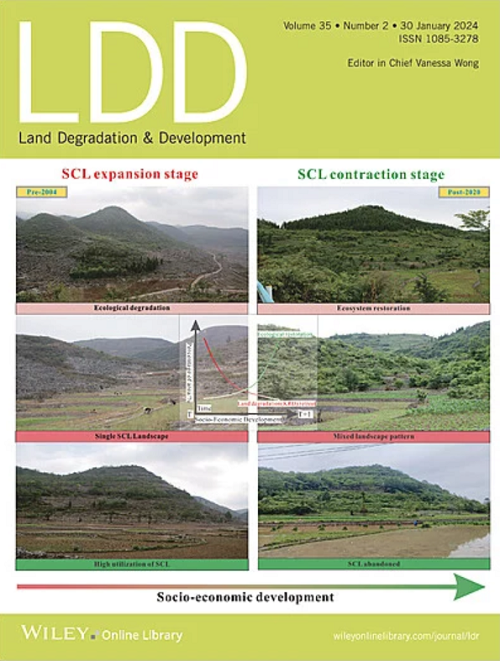气候变化对全球旱地土壤有机碳与无机碳相互作用的影响
IF 3.7
2区 农林科学
Q2 ENVIRONMENTAL SCIENCES
引用次数: 0
摘要
在旱地生态系统中,土壤无机碳(SIC)与土壤有机碳(SOC)同等重要,在固碳和生态系统稳定中都起着至关重要的作用。然而,以往的研究大多集中在气候变化对有机碳的影响上,导致对有机碳动态和有机碳-有机碳相互作用的理解有限。本研究利用全球169个干旱区植被恢复后的1131个土壤有机碳和土壤有机碳配对观测数据,研究了当前和未来气候变化对土壤有机碳、土壤有机碳以及土壤有机碳/土壤有机碳比值(SIC/SOC)的影响。结果表明:灌丛土壤SOC (20 ~ 100 cm)显著低于森林和草地,SIC/SOC显著高于草地和森林;SOC与SIC呈显著正相关(p <;0.05)。沿降水梯度,表层土壤(0 ~ 20 cm) SIC的增幅是SOC的1.29倍,深层土壤(>;100厘米)。同样,沿温度梯度,表层土壤SIC的增幅是表层土壤SOC的0.96倍,深层土壤SIC的增幅是表层土壤SOC的3.5倍。结构方程模型(SEM)表明,气候因子对土壤有机碳、碳化硅和碳化硅/有机碳均有直接和间接的影响,pH、总氮(TN)和含沙量是主要的中介变量。在不同的气候变化情景下,土壤有机碳和有机碳在不同土壤深度的变化范围很广,这表明预测未来土壤有机碳/有机碳动态存在很大的不确定性。SSP126情景下,土壤有机碳(SOC)在不同土层深度均增加23.7% ~ 66.6%,而SSP370情景下表层土壤碳化硅(SIC)减少幅度高达68.5%。我们的研究强调了平衡土壤有机碳和碳化硅的重要性,促进了对土壤碳动态的全面认识,并为应对旱地生态系统的气候变化提供了重要的科学支持。本文章由计算机程序翻译,如有差异,请以英文原文为准。
Effects of Climate Change on the Interaction Between Soil Organic and Inorganic Carbon in Global Drylands
In dryland ecosystems, soil inorganic carbon (SIC) is as important as soil organic carbon (SOC), with both playing vital roles in carbon sequestration and ecosystem stability. However, most previous studies have primarily focused on the impacts of climate change on SOC, leading to a limited understanding of SIC dynamics and SOC‐SIC interactions. In this study, we integrated 1131 paired SOC and SIC observations from 169 sites across global drylands following vegetation restoration and investigated the effects of current and future climate change on the SOC, SIC, and the ratio of SIC to SOC (SIC/SOC). The results indicated that subsoil SOC (20–100 cm) in shrubs was significantly lower than in forests and grasslands, while the SIC/SOC was significantly higher. A significant positive correlation was observed between SOC and SIC (p < 0.05). Along the precipitation gradient, the rate of SIC increase was 1.29 times greater than that of SOC in topsoils (0–20 cm) and 4.86 times greater in deeper soil layers (> 100 cm). Similarly, along the temperature gradient, the increase in SIC was 0.96 times greater than that of SOC in topsoils and 3.5 times greater in deeper soils. Structural equation modeling (SEM) revealed that climatic factors influence SOC, SIC, and SIC/SOC both directly and indirectly, with pH, total nitrogen (TN), and sand content serving as key mediating variables. Under different climate change scenarios, we observed a wide range of changes in SOC and SIC across soil depths, highlighting substantial uncertainty in predicting future SIC/SOC dynamics. Under the SSP126 scenario, SOC increased by 23.7%–66.6% across various soil depths, while SIC decreased by as much as 68.5% in the topsoil under SSP370. Our study highlights the importance of balancing SOC and SIC, advancing a comprehensive understanding of soil carbon dynamics, and providing critical scientific support for addressing climate change in dryland ecosystems.
求助全文
通过发布文献求助,成功后即可免费获取论文全文。
去求助
来源期刊

Land Degradation & Development
农林科学-环境科学
CiteScore
7.70
自引率
8.50%
发文量
379
审稿时长
5.5 months
期刊介绍:
Land Degradation & Development is an international journal which seeks to promote rational study of the recognition, monitoring, control and rehabilitation of degradation in terrestrial environments. The journal focuses on:
- what land degradation is;
- what causes land degradation;
- the impacts of land degradation
- the scale of land degradation;
- the history, current status or future trends of land degradation;
- avoidance, mitigation and control of land degradation;
- remedial actions to rehabilitate or restore degraded land;
- sustainable land management.
 求助内容:
求助内容: 应助结果提醒方式:
应助结果提醒方式:


